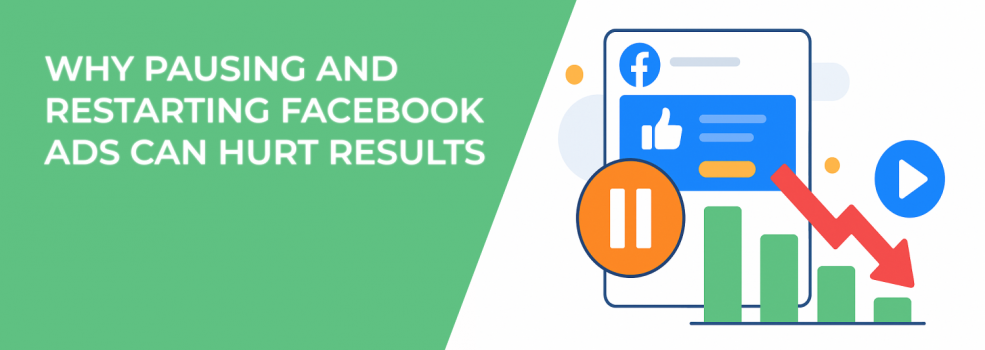Running Facebook Ads can feel like a roller coaster. Some days the leads are rolling in. Other days you stare at the numbers and wonder why you’re paying for clicks that don’t seem to convert.
When performance drops, many advertisers do the same thing — they hit pause. It feels like a quick fix to “stop the bleeding.” But in reality, pausing and restarting Facebook Ads often causes more harm than good.
Let’s dig into why this happens and what you can do instead.
The Learning Phase Gets Interrupted
Every Facebook ad starts with a learning phase. This is the period where Facebook’s algorithm is figuring things out — who engages, who converts, and how your budget can be used most effectively.
Think of it like training a new employee. At first, they’re slow, they make mistakes, and they need more guidance. But with time, they start to get better and eventually become efficient. If you pull them away halfway through training, they forget what they learned and need to start over. That’s exactly what happens when you pause ads.
When you stop ads during this phase, you risk:
-
Restarting the clock — your ad re-enters learning mode.
-
Wasting budget — because the system has to relearn what was already working.
-
Delaying conversions — since delivery won’t be optimized.
Each of these setbacks makes your ads more expensive and less predictable. If you’d like to shorten this process instead of constantly resetting it, here’s a resource on how to finish the Facebook learning phase quickly.
Tip: Instead of pausing, reduce your daily budget. Dropping from $50 a day to $10 still keeps your ad active and prevents lost progress.
Momentum Is Everything
Momentum is one of the most underrated parts of Facebook advertising. Once your ads have been running for a while, Facebook’s system learns how to deliver them more efficiently. This steady performance builds a rhythm that can improve your results over time.
To put it in perspective, think about going to the gym:
-
First week — hard, slow progress.
-
Month two — your body adapts, and workouts feel smoother.
-
Stop for a while — and when you return, it’s like starting over.
The same thing happens with campaigns. Once they stop, they lose the delivery rhythm that was driving efficiency.
That’s why planning is critical. If you know your budget is limited, it’s better to spread it out evenly than to burn it fast and pause.
Tip: Instead of running $50/day for six days and then pausing, run $10/day for 30 days. Consistency beats bursts every time.
Pausing Can Hurt in the Auction
Every Facebook ad competes in an auction. Your ads don’t just show up randomly — they’re ranked against thousands of others fighting for attention.
When your ads run consistently, Facebook builds a history of trust around them. But when you pause and restart, you interrupt that record. The result? You’re more likely to pay higher costs. Here’s what usually happens:
-
Your “trust score” drops — Facebook favors consistent ads.
-
Costs per click (CPC) rise — reintroduced ads often start higher.
-
Placements weaken — your ad may lose prime spots to steadier competitors.
For example, an ad with a CPC of $1.50 could easily jump to $2.20 after being paused. That small difference adds up quickly when you’re running campaigns at scale.
To learn more about this effect, take a look at what happens when you pause and restart Facebook campaigns.
Tip: If you only want ads live at certain times, don’t pause them manually. Use scheduling inside Ads Manager so your campaigns stay consistent without losing history.
Don’t Confuse Audience Fatigue with Algorithm Fatigue
One of the biggest misconceptions in advertising is that pausing ads prevents fatigue. But there are two different issues at play:
-
Audience fatigue — people see the same ad too many times and start ignoring it.
-
Algorithm fatigue — the system “forgets” optimizations because you paused.
Stopping ads doesn’t fix either problem. Instead, it disrupts delivery and costs you valuable learning data.
The smarter way to handle fatigue is to refresh your creatives. A few simple updates can make a huge difference:
-
Swap out images or videos with new visuals.
-
Rewrite the ad copy to highlight a different benefit.
-
Test a fresh call-to-action to spark clicks.
-
Change the background color or design for a quick facelift.
These small adjustments breathe new life into your ads without resetting their history. If you want to avoid burnout altogether, here’s a guide on how to spot ad fatigue early and fix it fast.
Tip: Check your ad frequency. If it’s higher than 3–4 and results are dropping, rotate creatives instead of pausing the entire campaign.
Smarter Moves Instead of Pausing
Pausing may feel like the easiest option, but there are far better ways to keep control of your campaigns. Before you hit that stop button, consider these alternatives:
-
Lower daily budgets — reduce spend while keeping the campaign alive.
-
Use scheduling — only run ads during hours when your audience is most active.
-
Rotate creatives — introduce new images, videos, or text before results dip.
-
Refine targeting — expand your reach or exclude audiences who no longer respond.
Each of these actions protects your campaign history while still giving you flexibility. For example, if your e-commerce ad isn’t converting, don’t kill it. Update the product photo, add urgency to your copy (“Only 3 left in stock”), or try a broader audience. You may see a rebound without losing all the optimization data you’ve paid for.
If you’re stuck and need deeper guidance, check out what to do when Facebook ads aren’t converting.
Final Thoughts
Facebook Ads are built on consistency. Pausing and restarting breaks that consistency and leads to four big problems:
-
The learning phase resets.
-
Momentum disappears.
-
Auction performance drops.
-
Costs go up over time.
The smarter approach is to manage your campaigns with tweaks instead of stop-start cycles. Lower budgets, schedule ads, refresh creatives, or fine-tune targeting — but don’t hit pause unless you absolutely have to.
Keep your ads running, protect your data, and make adjustments the smart way — not the stop-and-go way.

